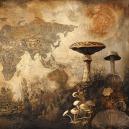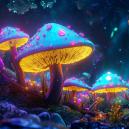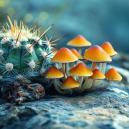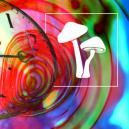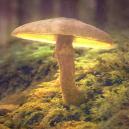New Species Of Psychedelic Lichen Discovered
Published :
October 28th, 2016
Categories :
Research

Breaking news! Dictyonema huaorani is a new species of lichen which tested positive for psychoactive ingredients. It is unique and extremely hard to find.
Imagine, distant lands of the Amazon, an abundance of animals and insects inhabiting the mystical jungle, tropical forests with vast territories unexplored, and a local tribe alienated from the outside world, speaking of legends about a psychedelic substance that lurked in the depths of the forest, unexplored for 80 years. Now imagine, after years of searching, the legendary substance was suddenly found.
Psychedelic explorers are perpetually searching for unique species of flora, fungi (and of course toads) to unearth new possibilities of achieving psychedelic experiences and to study unexplored medicinal substances. In 1981 E. Wade Davis and James A. Yost made an amazing discovery when they found an extremely rare species of lichen in eastern Ecuador. Davis and Yost traveled there to engage in ethnobotanical studies where they encountered the Waorani. The Waorani spoke the Huaorani language, which doesn’t share any linguistic similarities with any other language. It demonstrates the complete isolation of the tribe. The Waorani explained to Davis and Yost about their intriguing hallucinogenic activities:
"In the spring of 1981, whilst we were engaged in ethnobotanical studies in eastern Ecuador, our attention was drawn to a most peculiar use of hallucinogens by the Waorani, a small isolated group of some 600 Indians. Amongst most Amazonian tribes, hallucinogenic intoxication is considered to be a collective journey into the subconscious and, as such, is a quintessentially social event. The Waorani, however, consider the use of hallucinogens to be an aggressive anti-social act; so the shaman, or ido, who desires to project a curse takes the drug alone or accompanied only by his wife at night in the secrecy of the forest or in an isolated house ..."
Two hallucinogens were recorded to be used by the Waorani. The most prevalent one is called mii (Banisteriopsis muricata) which was the only plant used by the tribe. The plant contains the psychoactive ingredient DMT. The shaman "ido" prepared the drug by "scraping the bark of the liana and slowly boiling the brew". Other tribes make ayahuasca in the same way (although other tribes in different Amazonian locations may be using Banisteriopsis caapi instead).
The second species is an extremely rare lichenized basidiomycete. It has a "white hymenial layer and a bright green/blue upper surface". According to the Waorani: “It was last used some four generations ago - approximately eighty years - when 'bad shaman ate it to send a curse to cause other Waorani to die' ..." (it was written 35 years ago).
Davis and Yost heard references to this extremely rare species for seven years before finally encountering it. The Waorani call this lichen "nɇnɇndapɇ". Although they use this term for many fungi so it’s not necessarily very descriptive.
FAST FORWARD 33 YEARS ...
In 2014 Michaela Schmull with colleagues made a DNA analysis of this rare lichen and discovered that it was, in fact, an undiscovered species, which was named Dictyonema huaorani (which is a different spelling for Waorani). Using a liquid chromatography-mass spectrometry (LC-MS) techniques, Schmull’s team identified psilocybin, tryptamine, and 5-MeO-DMT, which are psychoactive ingredients.
Lichens are not a single organism. It’s a mix between fungus and alga, which work together in symbiosis. The outer layer (furthest away from the substrate) is called the cortex, which is made of fungal cells. The cortex protects the structure by providing moisture and protection for the alga. Underneath the cortex, alga cells are entangled in fungal threads which keep them in place. The alga photosynthesizes sugars, which allows the entire organism to thrive. Because of this quality lichens are extremely adaptive to most habitats in the world. So what makes this psychedelic lichen so special? Most lichens fungal component is Ascomycete, but approximately 1% of discovered lichens have Basidiomycete as their fungal part. In about 10% of lichens, the alga counterpart is not an alga, it's a compound called Cyanobacterium. The Dictyonema species combines both Basidiomycete and Cyanobacterium, which makes them very rare, also add the fact that Dictyonema huaorani is noted to have psychoactive properties which makes it quite a fascinating discovery because no Basidiomycete lichen was reported to contain psychoactive properties!
It's important to disclose that the study is not completely conclusive, it's more suggestive because without the reference compounds the team was unable to ascertain these psychoactive ingredients. Schmull and her colleagues give an explanation:
“Due to our inability to use pure reference compounds and scarce amount of sample for compound identification, however, our analyses were not able to determine conclusively the presence of hallucinogenic substances.” The lichens need water to thrive, and the reference compound was dried up for 33 years.
CONCLUSION
The war on drugs has created harsh laws which make the experimentation of psychedelic substances problematic; for over 40 years this has hindered scientists to progress in the psychedelic research field. Even though the Waorani used the Dictyonema huaorani for cursing fellow tribe members, science is needed to confront the reality of the lichen and explore it’s medicinal and psychedelic possibilities, as Davis and Yotes quoted “the genus is very poorly known and certainly deserves phytochemical investigation”. So next time you happen to swing by eastern Ecuador and meet up with the Waorani, don’t hesitate to go on a Dictyonema huaorani search in these mysterious depths of the Amazon.





